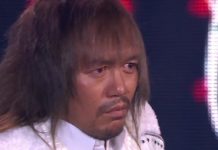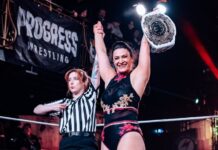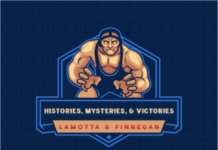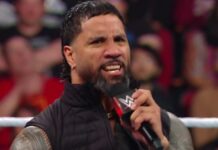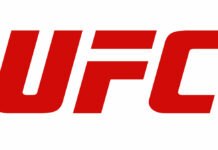After watching his retirement match with tears in my eyes, I really sat down with a new revelation: I think that Sting is the reason I’m here right now. For better or worse, Sting is a huge part of the reason I write and talk about wrestling as much as I do right now. No hyperbole. Now after 39 years in the business, we say goodbye and thank you to the Icon..The man that is Sting. But first, I gotta get there.
Here’s a short story that I told some of in my book, “Dream Master:”
Many years ago, my friend Austin told me about an idea he had about him and three friends forming a team of fun-loving, jovial characters taking the wrestling world by storm. Over pizza slices, he perfectly and thoroughly laid out the plan that these three men would eventually morph into what we know as The New Day,” almost a year before their television debut.
Although they had a rocky start, the group became a huge hit. As “The New Day,” Austin and his partners Kofi Kingston and Big E went on to hold the WWE Tag Team Championships on multiple occasions, and their on-screen chemistry is and has always been infectious. Most teams in wrestling usually break up after a year or two, with one of the members going on to super stardom while the others middle in obscurity, but The New Day has remained a unit and as of the date writing this, have the most tag team championship reigns of any active team in pro wrestling.
Whenever our paths would cross on the road, I’d call up Austin and invite him to Concerts or conventions, or he would invite me to wrestling events. Sometimes, as in the case of Wrestlemania, people fly all across the world to attend. Austin invited me to attend Wrestlemania 31 in San Jose in 2015, which was extra special for several reasons. During the weekend, my favorite wrestler, Macho Man Randy Savage, was getting inducted posthumously into the WWE Hall of Fame. Also, Sting, a man that I’d never thought I’d see wrestle again, was set to battle Triple H in a special match.
After the event, fireworks lit up the night sky as all the friends and family were ushered back to their buses to return to the talent hotel. With the benefit of police escorts there were no traffic delays. Once there, it was time for phase two. We changed, grabbed our After-Party wristbands and prepared for the nightlife at the hotel’s banquet hall.
Once inside the hall, I probably got jitters for the first time in my adult life, outside of a stage performance. I felt like an eleven-year-old at the Spectrum watching Wrestlemania V all over again… except these highly trained professional athletes weren’t on the Jumbotron; they were right in front of me. As soon as we walked in, I saw Booker T. Then Mark Henry, then Ric Flair… one legend after another. I couldn’t speak. I tried my best not to stare. The only way I could loosen up was with an adult beverage, so I did that. My goodness.
My dude Jason Ayers, ref and producer for WWE gave me the best advice when he told me, “we all get butterflies, you’ve just got to get them all to fly in the same direction.” It felt incredible being the least important person in that banquet hall. As an entertainer, I was accustomed to working a room, forced to smile and shake hands with everyone, networking or politicking in an attempt to gain an ally. I didn’t have to do that here. I was a fan and they knew it… I could just sit back and take it all in. And I did. I saw people I’d watched since childhood, as they danced, mingled, and partied the night away.
And then I saw him. The Man They Call Sting.
The man who was singlehandedly the reason I would flip back and forth on the TV between USA and TNT, when during an incredible storyline, Sting didn’t speak for a year, while contemplating if he would join the NWO or stay with the hometown team, WCW, as friend after friend questioned Sting’s loyalties and standing on the matter.
Letting his hair grow and donning a new facepaint design similar to the movie “The Crow,” the normally blonde and charismatic Stinger went dark, refusing to emote and vanishing from the scene, popping up from time to time to watch the action from the rafters. It was mysterious, and it was must-see TV.
When I saw The Stinger live in front of me, I walked up to him, praised his work and couldn’t believe how friendly and welcoming he was to a complete stranger. I’d imagine that people who hear “I love your work” every day of their lives would grow tired of it, but much like Bret Hart who I met a little earlier, Sting seemed just as engaged with me as he probably was all weekend at autograph signings in town. It just didn’t seem real. I was totally back into pro wrestling after this weekend and I had Austin to thank.
This reintroduction to the graps would help lead to my second major career pivot, one that put me in front of a completely new audience. Later that year in September during a tour, I found out I would visit Houston the same Sunday as the WWE were holding a pay-per-view event called Night of Champions. The show was main-evented by one of my favorite wrestlers of all time:Sting, making a much-anticipated comeback.
Sting was embarrassed earlier in the year at Wrestlemania and was returning at age fifty-seven, with a shot at the WWE Championship held by top bad guy Seth Rollins. Earlier on the match card was The New Day, defending their WWE Tag Team titles against another legendary team, The Dudley Boyz. The New Day won the match by disqualification and kept their titles, despite my boy Austin getting put through a table, which looked extremely painful. But no pain or carnage witnessed that night would prepare me for what went down during the main event.
Sting suffered a debilitating injury during the match when Seth Rollins performed a turnbuckle powerbomb, a move in which Seth, with a running start, tosses his opponent back and shoulder first into the turnbuckle pads. The move caused Sting’s neck to snap back violently, and it was later revealed he had suffered from spinal stenosis, an abnormal narrowing of the spinal canal resulting from pressure on the spinal cord.
We watched Sting’s final match. As we walked out of the Toyota Center, we saw an ambulance speeding away from the venue with its sirens wailing. “I bet that’s Sting,” I told a friend. It was. The event and the results made the show tough to watch back.
That night at my hotel, I decided to hit record on my iPhone and capture some of my immediate thoughts about the event and what I had seen. Since Wrestlemania, I had experienced wrestling through a completely different lens, as a professional entertainer myself. I released my recording onto the internet and the podcast called Mat Mania Was born. I named it after the first pro wrestling video game I had ever played, an arcade game by Technos released in 1985. My local pizzeria, Rocky’s, had the game and I would dump quarters into it to attempt to win the title and get the honor of inputting my initials on the High Score screen. “RJJ” wasn’t cool enough, so I began to input “RAD,” that looked sweet.
The wrestlers on Mat Mania were all completely made-up, but had captured the style of the 80s perfectly with characters like the Hawk and Animal-inspired Insane Warrior, the masked luchador The Pirania, and the wild man Coco Savage, who very closely resembled legendary wrestler Bobo Brazil.
I went from telling my own point of view on wrestling to suddenly becoming a member of the pro wrestling press, which was weird as it got me up close and personal with the sport I love, but also made me realize that my tweets and posts would pop up on dirt sheets once in a while, so I had to be careful what I shared.
Two years later at Wrestlecon in Dallas, I heard Sting was making an appearance, and he’s to this day the only wrestler I spent money to take a picture with. No regrets.
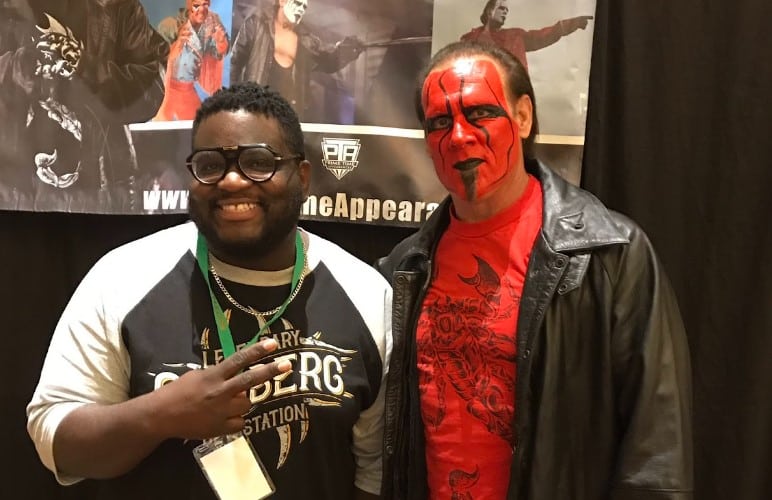
Overall though, the podcast has offered me a greater appreciation for the artform and the men and women that lay their bodies on the line. I also realized that the effort required to be successful at pro wrestling was much like what was needed for a musician–an iron will and a never ending fighting spirit. Also, there’s no handbook on how to become a success, but success is what you individually make of your opportunities.
Sting had done just that, when five years after this horrific injury, he showed up at the AEW Winter is Coming event, shocking the world. Sting didn’t just come back to just coast by and collect a paycheck, he went out there putting in WORK. He’s had some death defying dives and spots in his career, and has constantly had some of the most entertaining matches on the card since his return.
Just last week after winning an incredible main event match vs. The Young Bucks, Sting retired with an undefeated record in AEW, having won all 29 matches he competed in for the promotion. Record flawless, zero losses. Sting has been a winner his whole career, so he didn’t need a perfect record in AEW to prove that. And for that, we say Thank you, Sting.
He’s probably the only wrestler over 60 without a scandal: no racist allegations, no sexual misconduct or wild insinuations about his character. He was very vocal about steroid use and substance abuse early in his career, and has spent the last two decades fixing those mistakes with the help of family. He’s been arguably the most beloved pro wrestler for three decades, and ended his career just as popular and appealing as he started it. And for that, we say Thank you, Sting.
In a sport where there are so few happy endings; very few wrestlers get to ride off into the sunset on top, and even less nice guys get to finish first, Sting managed to beat the odds and go out in legendary fashion, living to get his flowers while he can still smell them. When the crowd chanted “you still got it” after his classic match in Greensboro, he told the audience, “no, YOU still got it.” Thankful and humble right to the end. And for that, we say Thank you, Sting.
Truly the wrestling fan’s wrestler, Sting may not be a household name like Stone Cold, The Rock or Hogan, but if you know, you know. When the time came to choose to defect to WWE or to walk, he chose to walk. He was the final holdout; eschewing the money and fame to keep a piece of himself that most folks lose on this journey. And for that, we say Thank you, Sting.
Will there ever be another? A 39-year career spanning every major promotion, 26 championship reigns, four-time Most Popular Wrestler of The Year, mentor to the young and old alike, a guy that no one has ONE bad thing to say about?
Not likely. Truly one of a kind. An Icon. A champion in the ring, and a champion in life.
Thank you, Sting.

